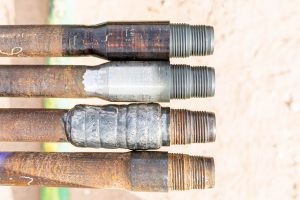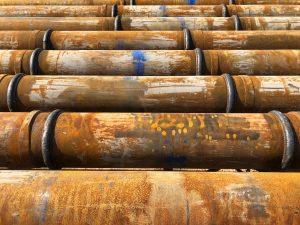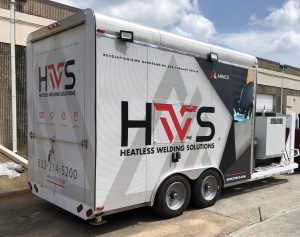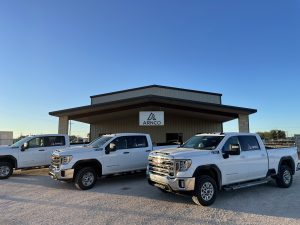
From bottom to top, a short and worn workstring tubing connection is extended and rebuilt using Arnco’s Heatless Tubular Repair (HTR™) as part of its Heatless Welding Solutions (HWS™), and subsequent machining and finishing.
While there is one main thing that affects the oil and gas industry—the price of the commodities in question—those commodities are subject to world politics and economics. The latter influences are many and varied, and are making today’s market anything but stable for everyone, including the service sector.
“It is changing at breakneck speed,” said Bill Jensen, the Manager of Technical Services for SPM Oil and Gas, a Caterpillar company. “What was normal five days ago is now replaced by something new. It seems like it’s that quick.”
With more than 40 years in the business, Jensen has seen changes, and even the rate of change is faster than before. “When I first started, a [whole] frac job was two hours.” Now two hours is just one stage of many.
Technology has advanced to where the down time between fracs has almost been completely eliminated, with companies now doing frac jobs basically 24 hours per day. “There’s minimal downtime between stages to shift between wells, where they’re doing either simulfrac or dual frac operations.” Changeover time is, Jensen said, just the time involved in closing one set of valves and opening another set.
Enabling this kind of speed requires equipment designers like SPM Oil & Gas “to develop equipment, including pumps, iron, and the support pieces that go with that to allow companies to get that benefit of extra productivity,” Jensen noted. High horsepower pumps such as SPM Oil & Gas’s QEM 5000 can operate continuously on the job, which push fluid at high rates to power multi frac jobs.
As producers also move toward energy efficiency and ESG concerns, power sources have expanded from the traditional 16-cylinder diesel engine alone, to include electric and gas blending options. Jensen pointed out that moving away from diesel does more than save the fuel used at the site, because diesel must be delivered regularly by diesel-powered trucks. Producers are moving toward treated gas from the wellhead because it involves no transportation, it is in plentiful supply, and it eliminates the need to buy fuel.
If flare gas is used, the fuel is basically free and even if gas is held out of the sales line to power fracs, it could be said it’s bought at wholesale. “I’ve heard numbers [saying] as high as $1 million can be saved annually in fuel costs where they’re able to use treated field gas” instead of diesel.
Technically Better
The growing role of technology in providing information and insights for both the oil field and for engineering and design is part of the mix for SPM Oil & Gas, said Jensen. “We’re using advanced technology in multiple different ways.” Software tools help model and manufacture new equipment and parts. From improving the stress levels and safety of parts to modeling flow characteristics of pipes, software improves both speed and accuracy in the design and testing process.
After modeling, new designs are tested in the company’s R&D facility in Fort Worth to check and verify those results in the real world, with the goal being to continually improve reliability and uptime to provide greater value to customers interested in speed and efficiency.
Using sensors to gather real-time field data helps analyze a situation that could cause equipment to fail and, with predictive maintenance, can prevent failures in many cases and inform preventive maintenance schedules.
For the big picture, Jensen said their software can inform yearly planning for opex, capex, and logistics by tracking what equipment may need maintenance or replacement over the next six months. The plan is to “provide the customer with the best cost-of-ownership model there is.”
Supply Side Economics
With the downturn and resultant supply chain challenges—which Jensen says have improved in recent months—SPM Oil & Gas is reimagining its planning process to stay ahead of the need for parts and supplies.
“We’re doing a better job of discussing these things with our customers—service companies, drilling companies, and others—to make sure we have as clear a picture of their needs going forward, which will allow us to provide service, parts, or other help when they need it,” Jensen said. “We’ll have the right people, the right parts in place, to work with the customer.”
Drill Pipe Hardbanding Reaches New Levels in Post-Pandemic

Arnco’s Heatless WearBanding (HWB™) is applied to drill pipe for the second time, extending the life of the tube bodies.
In 2018, with COVID-19 looming unseen over the horizon, Arnco Technology Trust, LP, decided to pour research dollars into improving their drill pipe hardbanding procedures. They wanted to invent a kind of welding that would revolutionize the industry and expand the reach of what hardbanding could protect.
They were almost ready to release the new service when everything shut down. The internal question was whether to mothball everything and wait for a brighter day or to forge ahead and be ready to roll when things did return, if they did.
An Inventive Weekend Started It All
For decades the family-owned company had been driven by innovation and product development, so they were not accustomed to waiting around.
Their entry into oil and gas began when inventor and entrepreneur Roman F. Arnoldy retreated to his cabin for the weekend about 30 years ago, laser focused on solving the issue of drill pipe wear.
“He came up with a product called 200XT, which really took the market by force,” said Austin Wells. Wells is the vice president of the company, of which Arnoldy was president at the time. Arnoldy’s son John Scott Arnoldy is the current president. “It was a big boon for the industry,” Wells said of 200XT. The product was delivered as rolled wire, to be welded onto pipe before sending it downhole.
The 200XT is a type of hardbanding, designed to protect drill pipe and downhole casing from wearing out under harsh oilfield conditions, saving drillers the cost of buying new pipe. Over the years Arnco has continued their R&D push, pioneering the concept of casing-friendly hardbanding, which is what protects both the casing from being worn down by the drill pipe as it turns in the hole.
Over the next decade Arnco’s leadership saw that hardbanding products had become commoditized as more and more companies offered similar products. While Arnco was a strong player in the market, they decided to branch out into the service sector. As a product provider, they had let others do the welding. They moved toward offering those welding services themselves, Wells said.
“We decided to focus on services because we had people flying around the world helping people figure out how to weld this niche product effectively, but we didn’t actually weld it ourselves. We thought, who better to weld it than ourselves?” They partnered with Lampo Hardbanding, opening new markets, especially in Texas’s Permian Basin, in Oklahoma, and in Louisiana.
The Hard Decision that Paid Off
In 2018 they embarked on a new round of innovation, said Wells. “We put a lot of money into R&D, back to the [company’s] roots, but on the services side this time. There were a couple of mandates. We wanted to weld differently than anybody ever had—to look at what the future of welding would be.”
The future would be to “repair pipe and protect it in ways that it couldn’t currently be done.”
From their research they developed Heatless Welding Solutions (HWS), which uses a lot less heat than traditional welding requires, while getting the same result. “That allows you to repair tools that otherwise couldn’t be welded on or repaired—or protect them if they’re really thin and otherwise unable to be protected.”
Arnco planned a big launch for the spring of 2020. They had to decide whether to park the new product and return to their previous business model or to forge ahead. “Fortunately, the board and all the management team agreed that the best thing to do would be to keep on this path and know that we were going to come out on the other side in a stronger position.”
Months later, as the oil business began to build back toward pre-pandemic levels, it happened. Oil prices rose but so did the costs of equipment and supplies—and the supply chain slowed to a crawl. Suddenly everyone needed to repair old pipe instead of buying new, and Arnco found it was perfectly positioned to supply that need. Its patent-pending HWS process took off, especially because they were “repairing certain tubulars that were never able to be repaired before,” said Wells.
He noted that at the beginning of 2022 steel prices had skyrocketed and the supply chain was constrained so that “this idea of improving the total-cost-of-ownership of pipe—of making it last longer, more than anything, because it just isn’t available—was a really strong driver for our customers, and still is.”
The process of preserving or repairing pipe had accelerated from a good idea to a dire necessity, and Arnco was ready with the perfect solution—after holding their corporate breath for a long time.
With a new Permian Basin facility on East County Road 119 in Midland, Wells is looking forward to growing the company’s business in this region.
“We’re working on our brand standards and increasing our visibility in the region and to being a good corporate citizen as well,” added Bryan Fitzhugh, the company’s CEO.
Leadership, even survival in the current climate, depends on finding the industry’s needs as they change, and adapting products and services to fit those trends, or on inventing new solutions.
______________________________________________________________________________________________________
Paul Wiseman is a freelance writer in the energy industry. His email address is fittoprint414@gmail.com.












